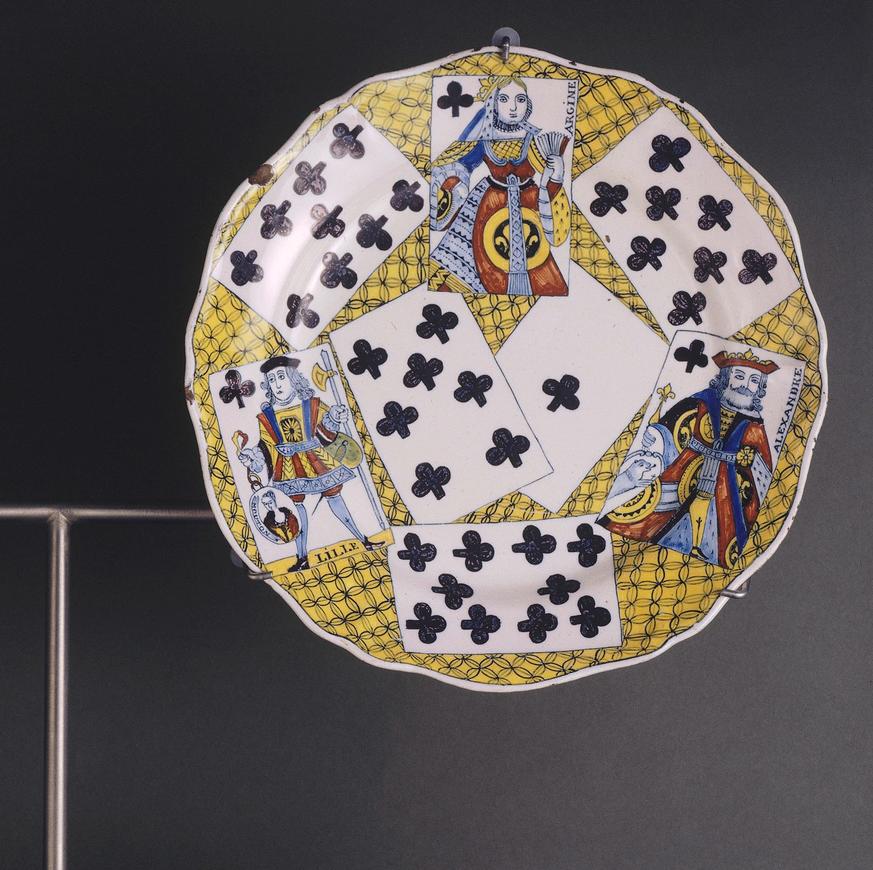The plates in this series present a yellow-grid background, upon which three figures appear – the king, the queen and the jack – as well as the numbered cards of each suit, from 7 to 10. In total, the plates feature 32 cards – the number required to play Piquet, a very popular game in the 18th century.
The cards are distributed according to the four traditional suits: hearts, diamonds, spades and clubs.
The clubs plate is the most interesting. In the French set, the face cards are identified by the names of valiant personalities – like Alexander, Caesar or Judith. These are brave men and women, taken from the bible or famous legends. But a single character remains anonymous: the jack of clubs. Why have they all been named, except for him?
This particularity is, in fact, a legal obligation. Since 1613, playing-cards manufacturers were required to write the name and origin of their factory on the jack of clubs card. Here, he holds a coat of arms in his hand, featuring a woman and the inscription "Mouton". Between his feet, reads the word "Lille". The set which inspired this series of plates was therefore made in the Mouton factory, in Lille!
Ever since playing cards began to be made en masse, this practice became obsolete. The famous jack has therefore gained a name. The next time you play poker or belote, take a look at the jack of clubs. His name is Lancelot, in reference to Lancelot of the Lake, the hero of the King Arthur legend!
Detail: The characters bear the emblem of Lille on their clothing – the fleur-de-lis. This is known as a canting arms. In Latin, the lily (lis) was known as "lilia", pronounced similarly to Lille. This particularity is, in fact, a legal obligation.

The plates in this series present a yellow-grid background, upon which three figures appear – the king, the queen and the jack – as well as the numbered cards of each suit, from 7 to 10. In total, the plates feature 32 cards – the number required to play Piquet, a very popular game in the 18th century.
The cards are distributed according to the four traditional suits: hearts, diamonds, spades and clubs.
The clubs plate is the most interesting. In the French set, the face cards are identified by the names of valiant personalities – like Alexander, Caesar or Judith. These are brave men and women, taken from the bible or famous legends. But a single character remains anonymous: the jack of clubs. Why have they all been named, except for him?
This particularity is, in fact, a legal obligation. Since 1613, playing-cards manufacturers were required to write the name and origin of their factory on the jack of clubs card. Here, he holds a coat of arms in his hand, featuring a woman and the inscription "Mouton". Between his feet, reads the word "Lille". The set which inspired this series of plates was therefore made in the Mouton factory, in Lille!
Ever since playing cards began to be made en masse, this practice became obsolete. The famous jack has therefore gained a name. The next time you play poker or belote, take a look at the jack of clubs. His name is Lancelot, in reference to Lancelot of the Lake, the hero of the King Arthur legend!
Detail: The characters bear the emblem of Lille on their clothing – the fleur-de-lis. This is known as a canting arms. In Latin, the lily (lis) was known as "lilia", pronounced similarly to Lille. This particularity is, in fact, a legal obligation.